![]()
![]()
![]()
Use LEFT and RIGHT arrow keys to navigate between flashcards;
Use UP and DOWN arrow keys to flip the card;
H to show hint;
A reads text to speech;
76 Cards in this Set
- Front
- Back
|
define anisotropic |
not going all same direction |
|
|
define electron volt |
kinetic energy gained by one electron when it is accelerated by one volt |
|
|
define cross section |
model of a nucleus as a completely absorbing cross section |
|
|
equation for einsteins relation and the reletivistic relation |
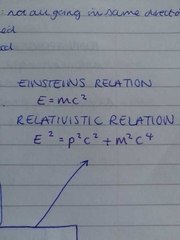
|
|
|
units of cross section |
barn = 10^-28 |
|
|
equation for fermi's golden rule |
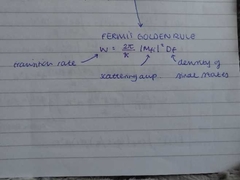
|
|
|
Born approximations |
- assume single scattering -initial and final states are defined by plane waves -ignore recoil from nucleus |
|
|
equation for scattering amplitude Mfi |
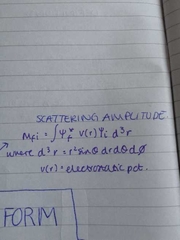
|
|
|
special cases of form factor |
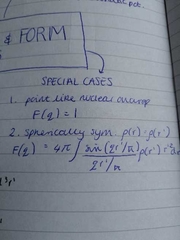
|
|
|
definition of a boson |
-integar spin -can be created and destroyed -are own antiparticles -symmetric when particles are interchanged |
|
|
definition of a fermion |
-half integar spin -include constituent particles of matter -produced as fermion antifermion pairs -antisymmetic when particles are interchanged |
|
|
definition of a quark |
Baryon number of ±1/3 up and down |
|
|
definition of a lepton |
lepton number conserved electrons and neutrinos generations: Le Lu Lt (increasing mass) |
|
|
define quantum mechanical potential |
probability distribution |
|
|
define quantum field theory |
interacts at very small distances |
|
|
define virtual photon |
only exist with the freedom of the uncertainty principle and for a short period of time |
|
|
two types of field |
fermion acts as a source and boson propagates both fermion and boson are sources |
|
|
source, particle, spin, mass and strength of strong force |
colour gluon spin 1 mass 0 ~1 at large distances and <1 at small distances |
|
|
source, particle, spin, mass and strength of EM force |
charge photons spin 1 mass 0 ~10^-2 |
|
|
source, particle, spin, mass and strength of weak force |
leptons and quarks W±, Z spin 1 mass 80-90Gev/c^2 ~10^-15 @10^-15m ~10^-2 @10^-18 |
|
|
source, particle, spin, mass and strength of gravity |
energy density graviton G spin 2 mass 0 ~10^-38 |
|
|
equations for momentum q and resultant force |
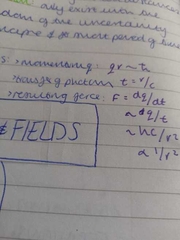
|
|
|
reletivistic relation to wave equation |

|
|
|
equation for yukawa potential |
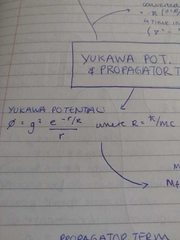
|
|
|
matrix element Mfi |
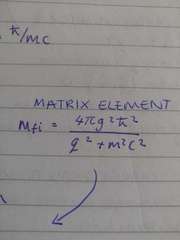
|
|
|
propagator term |
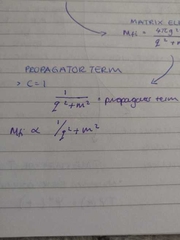
|
|
|
define invariance principle |
reflects a basic symmetry and is always related to a Conservation law |
|
|
generator of translations |

|
|
|
invariance in Hamiltonian |
leads to conservation of momentum |
|
|
CPT invariance |
weak interactions are invariant under CP all interactions are invariant under CPT |
|
|
combining conservation laws |
continuous transformation = additive discrete transformation = multiplicative |
|
|
Charge operator Q |
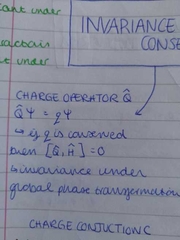
|
|
|
Partity operator P |
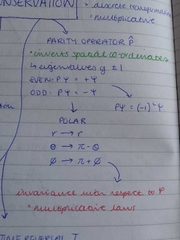
|
|
|
Charge conjunction C |
changes particles into antiparticles |
|
|
time reversal T |
reverses time coordinate |
|
|
number for cross section, alpha |
1/137 |
|
|
magnetic moment in terms of atomic and QM |
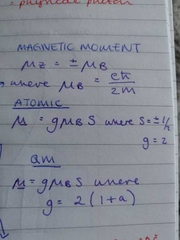
|
|
|
anomalous magnetic moment a |
in order of alpha 1/137 |
|
|
High order process for altering magnetic moment |
- electron surrounded by cloud of virtual photons - charge carried by electron - mass and energy shared by electron and cloud of photons - value of e/m for bare electron increases so magnetic moment increases |
|
|
properties that lead to postulation of weak force |
- low rates and long lifetimes - violation of conservation laws - frequent involvement of neutrinos |
|
|
cross sections at low energy |
cross section proportional to G |
|
|
define strong interaction |
binds constituents of nucleons and other hadrons |
|
|
properties of strong interaction |
- only acts on quarks - strong - overcomes coulomb repulsion -binds qqq or qqbar |
|
|
what happens if a quark is ejected |
- colour field builds up and creates a quark antiquark pair to reduce fieldn - new pair are attracted to original particle and produced colourless meson and baryon |
|
|
what colour can a quark be |
Red, green or blue |
|
|
equations for electric charge |
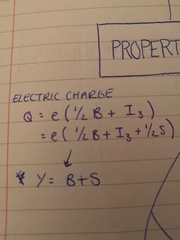
|
|
|
properties of isospin |
- hypothetical space - charge can be due to change in isospin - wavefunction is always antisymmetic - conservation of strong interactions |
|
|
isospin of pions |
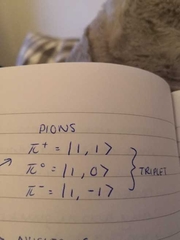
|
|
|
isospin of nucleons |

|
|
|
isospin of quarks |

|
|
|
overall wavefunction |
must be overally antisymmetic |
|
|
define strangeness |
unusual stability for strongly interacting particles - strange particles can only decay by weak interactions |
|
|
charm quark |
- charge 2/3 - partner to s quark |
|
|
3rd pair of quarks |
top/truth bottom/beauty |
|
|
generation of fermions |
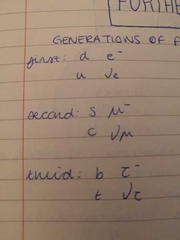
|
|
|
symmetry of pn and np |
no defined symmetry |
|
|
combining two nucleons |
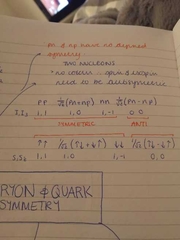
no colour and therefore spin and isospin need to be antisymmetic |
|
|
combining quarks |

has colour so isospin x spin must be symmetric |
|
|
weak isospin |
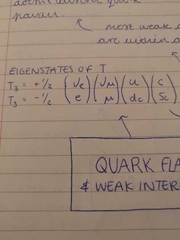
T, T3 doesn't conserve quark flavour |
|
|
dc and sc |
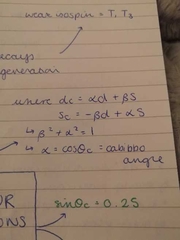
|
|
|
most likely decay chain |
t > b > c > s > u |
|
|
strong and weak eigenstates of down and strange |

|
|
|
mixing matrix of three generations |

|
|
|
k0 reaction |

|
|
|
k0 bar reaction |
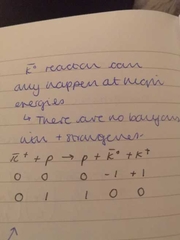
|
|
|
k1 and k2 |
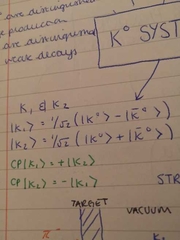
distinguished by their weak decays |
|
|
distinguishing between k0 and k0 bar |
weak interactions don't conserve strangeness but CP is conserved |
|
|
strangeness regeneration |
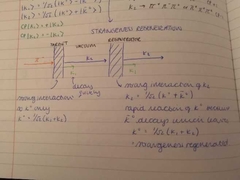
|
|
|
electron positron annihilation |
produces particle antiparticle pair that proceeds through a time like virtual photon |
|
|
cross section for energies at 2x rest mass of quark |
cross section = z^2e^4 |
|
|
ratio R |
must be over all colours and flavours |
|
|
R at low energies |
2 |
|
|
R at higher energies |
3 1/2 - 3 2/3 |
|
|
inelastic scattering |
- evidence for point like particles |
|
|
elastic scattering |
- if you take nucleons to be made of point like particles then q^2/2mv will be constant for elastic scattering however quarks are not at rest |
|
|
k0 at low energies |
only get pure samples of k0, no k0 bar |

